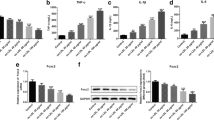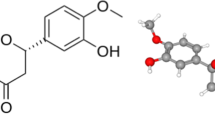Abstract
Steroidogenic acute regulatory protein (StAR) plays an important role in the maintenance of intracellular lipid homeostasis. Macrophages are the key cellular player in the pathophysiology of atherosclerosis. Imbalance of macrophage lipid homeostasis causes cellular apoptosis, which is the key process in the initiation of atherosclerosis. The present study has investigated the effects of StAR in the apoptotic process of human THP-1 derived macrophages induced by serum withdrawal or Ox-LDL. Overexpression of StAR significantly decreased the number of apoptotic macrophages by decreasing the expression of pro-apoptotic genes Caspase-3 and Bax mRNA and protein levels, as well as through increasing expression of anti-apoptotic gene Bcl-2 mRNA and protein levels in the absence and presence of Ox-LDL. The results indicate that StAR plays an important role in macrophage and foam cell apoptotic processing, which may provide a potential method for preventing atherosclerosis.




Similar content being viewed by others
Abbreviations
- ABCG1:
-
ATP-binding cassette transporter G1
- ApoE−/−:
-
Apolipoprotein E-deficient
- Bax:
-
BCL2-associated X protein
- Bcl-2:
-
B cell lymphoma/leukemia-2
- CYP27A1:
-
Sterol 27-hydroxylase
- EGFP:
-
Enhanced green fluorescence protein
- FC:
-
Free cholesterol
- FCM:
-
Flow cytometry
- GAPDH:
-
Glyceraldehyde-3-phosphate dehydrogenase
- IMM:
-
Inner mitochondrial membrane
- LDL:
-
Low-density lipoprotein
- LXRα:
-
Liver X receptor alpha
- MOI:
-
Multiplicity of infection
- OMM:
-
Outer mitochondrial membrane
- Ox-LDL:
-
Oxidized low-density lipoprotein
- PE:
-
Phycoerythrin
- PMA:
-
Phorbol 12-myristate 13-acetate
- PPARγ:
-
Proliferation peroxysome activator receptor gamma
- P450scc:
-
Side-chain cleavage cytochrome P450
- StAR:
-
Steroidogenic acute regulatory protein
- THP-1:
-
Human, peripheral blood, leukemia, acute monocytic
- TUNEL:
-
Terminal deoxynucleotidyl transferase-mediated dUTP nick end labeling
- 7-ADD:
-
7-Amino-actinomycin
- 25HC:
-
25-Hydroxycholesterol
- 25HC3S:
-
Sulfated 25-hydroxycholesterol
- 27HC:
-
27-Hydroxycholesterol
References
Bobryshev YV (2006) Monocyte recruitment and foam cell formation in atherosclerosis. Micron 37:208–222
Hansson GK (2005) Inflammation, atherosclerosis, and coronary artery disease. N Engl J Med 352:1685–1695
Yamada Y, Doi T, Hamakubo T, Kodama T (1998) Scavenger receptor family proteins: roles for atherosclerosis, host defence and disorders of the central nervous system. Cell Mol Life Sci 54:628–640
Pennings M, Meurs I, Ye D et al (2006) Regulation of cholesterol homeostasis in macrophages and consequences for atherosclerotic lesion development. FEBS Lett 580:5588–5596
Tabas I (2002) Consequences of cellular cholesterol accumulation: basic concepts and physiological implications. J Clin Investig 110:905–911
Zhou J, Chew M, Ravn HB, Falk E (1999) Plaque pathology and coronary thrombosis in the pathogenesis of acute coronary syndromes. Scand J Clin Lab Investig Suppl 230:3–11
Corsten MF, Reutelingsperger CP, Hofstra L (2007) Imaging apoptosis for detecting plaque instability: rendering death a brighter facade. Curr Opin Biotechnol 18:83–89
Glass CK, Witztum JL (2001) Atherosclerosis. The road ahead. Cell 104:503–516
Miller WL (2007) Steroidogenic acute regulatory protein (StAR), a novel mitochondrial cholesterol transporter. Biochim Biophys Acta 1771:663–676
Hall EA, Ren S, Hylemon PB et al (2005) Detection of the steroidogenic acute regulatory protein, StAR, in human liver cells. Biochim Biophys Acta 1733:111–119
Pandak WM, Ren S, Marques D et al (2002) Transport of cholesterol into mitochondria is rate-limiting for bile acid synthesis via the alternative pathway in primary rat hepatocytes. J Biol Chem 277:48158–48164
Ning Y, Bai Q, Lu H et al (2009) Overexpression of mitochondrial cholesterol delivery protein, StAR, decreases intracellular lipids and inflammatory factors secretion in macrophages. Atherosclerosis 204:114–120
Ning Y, Xu L, Ren S et al (2009) StAR overexpression decreases serum and tissue lipids in apolipoprotein E-deficient mice. Lipids 44(6):511–519
Bjorkerud S, Bjorkerud B (1996) Apoptosis is abundant in human atherosclerotic lesions, especially in inflammatory cells (macrophages and T cells), and may contribute to the accumulation of gruel and plaque instability. Am J Pathol 149:367–380
Harada-Shiba M, Kinoshita M, Kamido H, Shimokado K (1998) Oxidized low density lipoprotein induces apoptosis in cultured human umbilical vein endothelial cells by common and unique mechanisms. J Biol Chem 273:9681–9687
Schulz T, Schiffl H, Scheithe R, Hrboticky N, Lorenz R (1995) Preserved antioxidative defense of lipoproteins in renal failure and during hemodialysis. Am J Kidney Dis 25:564–571
Pandak WM, Bohdan P, Franklund C et al (2001) Expression of sterol 12alpha-hydroxylase alters bile acid pool composition in primary rat hepatocytes and in vivo. Gastroenterology 120:1801–1809
Ren S, Hylemon P, Marques D et al (2004) Effect of increasing the expression of cholesterol transporters (StAR, MLN64, and SCP-2) on bile acid synthesis. J Lipid Res 45:2123–2131
Dai ZJ, Gao J, Ji ZZ, Wang XJ, Ren HT, Liu XX, Wu WY, Kang HF, Guan HT (2009) Matrine induces apoptosis in gastric carcinoma cells via alteration of Fas/FasL and activation of caspase-3. J Ethnopharmacol 123(1):91–96
Vermes I, Haanen C, Steffens-Nakken H, Reutelingsperger C (1995) A novel assay for apoptosis. Flow cytometric detection of phosphatidylserine expression on early apoptotic cells using fluorescein labelled Annexin V. J Immunol Methods 184:39–51
Ning Y, Chen S, Li X, Ma Y, Zhao F, Yin L (2006) Cholesterol, LDL, and 25-hydroxycholesterol regulate expression of the steroidogenic acute regulatory protein in microvascular endothelial cell line (bEnd.3). Biochem Biophys Res Commun 342:1249–1256
Ross R, Rous-Whipple Award Lecture (1993) Atherosclerosis: a defense mechanism gone awry. Am J Pathol 143:987–1002
Stary HC, Chandler AB, Dinsmore RE et al (1995) A definition of advanced types of atherosclerotic lesions and a histological classification of atherosclerosis. A report from the Committee on Vascular Lesions of the Council on Arteriosclerosis, American Heart Association. Arterioscler Thromb Vasc Biol 15:1512–1531
Libby P, Geng YJ, Aikawa M et al (1996) Macrophages and atherosclerotic plaque stability. Curr Opin Lipidol 7:330–335
Miller WL (1988) Molecular biology of steroid hormone synthesis. Endocr Rev 9:295–318
Miller WL (2007) StAR search—what we know about how the steroidogenic acute regulatory protein mediates mitochondrial cholesterol import. Mol Endocrinol 21:589–601
Ma Y, Ren S, Pandak WM et al (2007) The effects of inflammatory cytokines on steroidogenic acute regulatory protein expression in macrophages. Inflamm Res 56:495–501
Wyllie AH (1980) Glucocorticoid-induced thymocyte apoptosis is associated with endogenous endonuclease activation. Nature 284:555–556
Falcieri E, Gobbi P, Zamai L, Vitale M (1994) Ultrastructural features of apoptosis. Scanning Microsc 8:653–665 (discussion 665–666)
Brown MS, Goldstein JL (1983) Lipoprotein metabolism in the macrophage: implications for cholesterol deposition in atherosclerosis. Annu Rev Biochem 52:223–261
Clare K, Hardwick SJ, Carpenter KL, Weeratunge N, Mitchinson MJ (1995) Toxicity of oxysterols to human monocyte-macrophages. Atherosclerosis 118:67–75
Hardwick SJ, Hegyi L, Clare K et al (1996) Apoptosis in human monocyte-macrophages exposed to oxidized low density lipoprotein. J Pathol 179:294–302
Li W, Yuan XM, Brunk UT (1998) OxLDL-induced macrophage cytotoxicity is mediated by lysosomal rupture and modified by intralysosomal redox-active iron. Free Radic Res 29:389–398
Li D, Yang B, Mehta JL (1998) Ox-LDL induces apoptosis in human coronary artery endothelial cells: role of PKC, PTK, bcl-2, and Fas. Am J Physiol 275:H568–H576
Siow RC, Richards JP, Pedley KC, Leake DS, Mann GE (1999) Vitamin C protects human vascular smooth muscle cells against apoptosis induced by moderately oxidized LDL containing high levels of lipid hydroperoxides. Arterioscler Thromb Vasc Biol 19:2387–2394
de Nigris F, Franconi F, Maida I, Palumbo G, Anania V, Napoli C (2000) Modulation by alpha- and gamma-tocopherol and oxidized low-density lipoprotein of apoptotic signaling in human coronary smooth muscle cells. Biochem Pharmacol 59:1477–1487
Haendeler J, Zeiher AM, Dimmeler S (1996) Vitamin C and E prevent lipopolysaccharide-induced apoptosis in human endothelial cells by modulation of Bcl-2 and Bax. Eur J Pharmacol 317:407–411
Schroepfer GJ Jr (2000) Oxysterols: modulators of cholesterol metabolism and other processes. Physiol Rev 80:361–554
Li X, Pandak WM, Erickson SK et al (2007) Biosynthesis of the regulatory oxysterol, 5-cholesten-3beta, 25-diol 3-sulfate, in hepatocytes. J Lipid Res 48:2587–2596
Ren S, Hylemon P, Zhang ZP et al (2006) Identification of a novel sulfonated oxysterol, 5-cholesten-3beta, 25-diol 3-sulfonate, in hepatocyte nuclei and mitochondria. J Lipid Res 47:1081–1090
Ma Y, Xu L, Rodriguez-Agudo D et al (2008) 25-Hydroxycholesterol-3-sulfate (25HC3S) regulates macrophage lipid metabolism via the LXR/SREBP-1 signaling pathway. Am J Physiol Endocrinol Metab 295:E1369–E1379
Acknowledgments
This work was supported by the National Natural Science Foundation of China (NSFC 30871021 and NSFC 30800547).
Author information
Authors and Affiliations
Corresponding author
About this article
Cite this article
Bai, Q., Li, X., Ning, Y. et al. Mitochondrial Cholesterol Transporter, StAR, Inhibits Human THP-1 Monocyte-Derived Macrophage Apoptosis. Lipids 45, 29–36 (2010). https://doi.org/10.1007/s11745-009-3375-6
Received:
Accepted:
Published:
Issue Date:
DOI: https://doi.org/10.1007/s11745-009-3375-6




